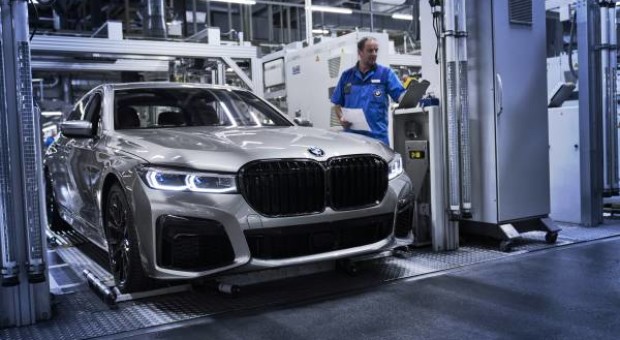
Production of the new BMW 7 Series Sedan got underway at BMW Group Plant Dingolfing just a few days ago. Roughly three-and-a-half years after the sixth generation was launched, the BMW brand’s top model has been thoroughly revised and given greater presence.
The so-called “digital launch” presented a particular challenge for the production start: It means production of a new vehicle is ramped up to the full daily volume from one day to the next. To ensure high quality standards are fulfilled from the very first vehicle, complex components underwent virtual testing for fit accuracy prior to the start of production.
Since production of the first 7 Series began in 1977, more than 1.9 million BMW 7 Series cars have been built in Dingolfing. From the very beginning, the global market was crucial to the success of the luxury sedan. The BMW 7 Series is easily the number-one export from the plant in Lower Bavaria. Last year, over 90 percent of all units produced were exported abroad. The Chinese market plays an especially important role for the model: In 2018, 44 percent of global sales were delivered to customers in China.
New exterior design accents
The redesigned front and rear ends give the new BMW 7 Series a uniquely expressive appearance. At the front, the enlarged kidney grille contrasts very effectively with the slim headlights. As a result, the BMW 7 Series is clearly recognisable as part of the new BMW luxury segment and fits in with the design language of the BMW 8 Series and the BMW X7.
The rear-end design also brings fresh accents: The flatter three-dimensional rear lights rely completely on LED technology. Beneath the chrome bar between the two rear lights, there is now a slim six-millimetre light strip, which creates a discreetly illuminated accent when daytime running lights are switched on and produces a distinctive night-time design in the dark. There are also special rear lighting effects when the car is locked and unlocked.
The BMW 7 Series will continue to be available in two body variants, including the Long Wheelbase version with its 14-cm-longer wheelbase. 80 percent of customers opt for this version, which offers even more space in the rear.
The interior of the new BMW 7 Series Sedan is now also available with extended quilting around the centre console and in the armrests integrated in the door trim. New fine-wood interior trim is also available. Improved acoustic shielding in the rear wheel arches reduces the level of tire noise noticeable in the interior. To further enhance acoustic comfort, the side windows now also come with increased material thickness.
Six-cylinder plug-in hybrid debuts in the new BMW 7 Series
For the first time in a BMW Group vehicle, a plug-in hybrid will be available with a six-cylinder engine. In the BMW 745e / 745Le (combined fuel consumption: 2.3 – 2.1 l/100 km / 2.3 – 2.2 l/100 km; combined power consumption: 15.6 – 15.1 kWh/100 km / 15.7 – 15.6 kWh/100 km; combined CO2 emissions from fuel: 2 – 48 g/km* / 53 – 50 g/km*), a 286 horsepower six-cylinder inline engine is combined with a 113 horsepower electric engine, for a total system output of 394 horsepower. The new BMW 7 Series is the first BMW Group vehicle with a fourth-generation battery. The latest battery-cell technology gives the luxury sedan an all-electric driving range of up to 58 kilometres*, ensures local emission-free driving and is virtually silent. The battery installed in the BMW 745e / 745Le is manufactured in Dingolfing, just a few kilometres away, at the Competence Centre for e-drive Production (component plant 02.20).
From there, Dingolfing already supplies BMW Group vehicle plants worldwide with batteries and electric engines for production of electrified vehicles.
Digitalisation supports BMW 7 Series production process
The production process for Dingolfing’s top model is supported by a range of innovative solutions. For assembly of less-ordered special equipment, like the rear centre console, the vibrating alarm of a smartwatch alerts employees on the corresponding section of the line that an “exotic” is coming up and gives them instructions for additional work steps.
Data glasses are also used in training new staff. When learning new work steps, virtual assistance is projected into the employee’s field of vision. This enables rapid, sustainable learning in pre-assembly of complex components like the rear light. This augmented-reality application is used at assembly training centres and constantly refined in agile working methods in close cooperation between production planning and IT.
Digitalisation is also making further inroads in supplying assembly lines with components. The latest generation of autonomous tugger trains is currently being piloted on longer routes between the warehouse and assembly hall. The capabilities of driverless tugger trains go beyond automation of earlier solutions. New and smarter logistics helpers will enable dynamic route guidance according to delivery priority, with active obstacle avoidance.
Source: BMW Europe
















